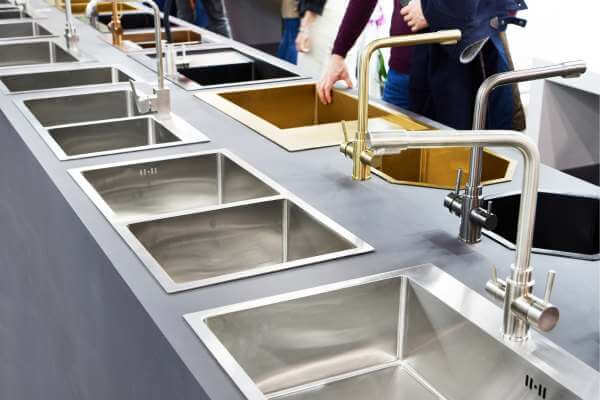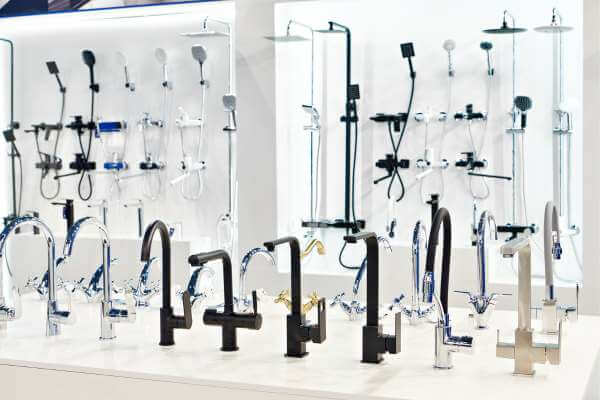When it comes to renovating or upgrading your kitchen, the faucet is not always the first thing that comes to mind. However, a new kitchen faucet can make a significant difference in both the functionality and style of your kitchen. With so many options available, it can be overwhelming to choose the right one. In this article, I will guide you through the process of buying a kitchen faucet.

The first thing to consider when buying a kitchen faucet is the type of faucet you want. There are several types of faucets to choose from, including single-handle, double-handle, pull-down, and pull-out faucets. Each type has its advantages and disadvantages, so it’s important to choose one that fits your needs. For example, if you have a small sink, a single-handle faucet may be the best option as it takes up less space than a double-handle faucet. On the other hand, if you need more flexibility when washing dishes, a pull-down or pull-out faucet may be a better choice.
Another important factor to consider when buying a kitchen faucet is the style and finish. The style of the faucet should match the overall design of your kitchen, while the finish should complement your other fixtures and appliances. Some popular finishes include chrome, stainless steel, brass, and oil-rubbed bronze. Additionally, you should consider the durability of the finish and how easy it is to clean. By taking these factors into account, you can choose a kitchen faucet that not only looks great but also functions well for years to come.
Understanding Faucet Types
When it comes to choosing a kitchen faucet, it’s important to understand the different types available. Each type has its own unique features and benefits, so it’s essential to consider your specific needs and preferences before making a decision.
Pull-Down and Pull-Out Faucets
Pull-down and pull-out faucets are popular options for modern kitchens. They feature a retractable spray hose that allows for easy maneuverability and efficient cleaning. Pull-down faucets have a tall, arched spout that offers ample space for filling large pots and cleaning dishes, while pull-out faucets are more compact and versatile for various kitchen tasks.
Single-Handle vs. Two-Handle
When it comes to the number of handles, you have the choice between single-handle and two-handle faucets. Single-handle faucets are convenient and easy to use, allowing for effortless temperature and flow control with one hand. On the other hand, two-handle faucets provide separate handles for hot and cold water, offering precise control over water temperature.
Wall-Mounted and Deck-Mounted Options
Wall-mounted and deck-mounted faucets are installation options to consider. Wall faucets create a sleek and modern look, while deck-mounted faucets are installed directly on the countertop or sink. Both options have their advantages, so it’s important to assess your kitchen layout and design preferences to determine the most suitable choice for your space.
By understanding the different faucet types and their features, you can make an informed decision that aligns with your kitchen needs and aesthetic preferences.
Key Features to Consider When Buying a Kitchen Faucet

When it comes to buying a kitchen faucet, it’s important to consider several key features that can greatly impact your overall experience. In this section, I will cover the three most important features to consider: spout height and reach, spray functions, and smart faucet technology.
Spout Height and Reach
The spout height and reach are important factors to consider when selecting a kitchen faucet. The height of the spout should be high enough to accommodate the largest pots and pans that you use in your kitchen. The reach of the spout should also be long enough to easily fill those pots and pans without splashing water all over your counter.
Spray Functions
Spray functions are another important feature to consider when selecting a kitchen faucet. Some faucets come with a sprayer that can be pulled out from the spout and used to rinse dishes or fill pots. Other faucets come with a separate sprayer that can be mounted on the side of the sink. Consider which type of spray function will work best for your needs.
Smart Faucet Technology
Smart faucet technology is becoming increasingly popular in modern kitchens. Hands-free and touchless faucets are now available that use motion sensors to turn the water on and off. This can be a convenient feature when your hands are full or dirty. Some smart faucets also come with temperature and flow control, allowing you to set the water to your desired temperature and flow rate.
Overall, when buying a kitchen faucet, it’s important to consider your specific needs and preferences. By taking the time to research and compare different features and brands, you can find a faucet that will meet your needs and provide you with a great user experience.
Material and Finish Options

When it comes to buying a kitchen faucet, one of the most important considerations is the material and finish. The finish not only affects the faucet’s appearance but also its durability and resistance to corrosion. Here are some of the most common material and finish options available.
Stainless Steel, Chrome, and Nickel
Stainless steel, chrome, and nickel are some of the most popular finishes for kitchen faucets. They are all highly durable and resistant to corrosion, making them ideal for high-use areas like the kitchen. Stainless steel has a modern, industrial look that is popular in contemporary kitchens, while chrome and nickel have a more classic, timeless look that can fit into any kitchen style.
Copper, Brass, and Alternative Finishes
Copper and brass are alternative finishes that can add warmth and character to a kitchen faucet. They are less common than stainless steel, chrome, and nickel but can be a great choice if you want to create a unique, eclectic look. However, these finishes require more maintenance than their counterparts and can tarnish over time.
Other alternative finishes include powder-coated decorator colors such as white, black, red, and gray. These finishes can add a pop of color to your kitchen and are a great way to make a statement. However, they may not be as durable as other finishes and can chip or scratch over time.
When choosing a finish for your kitchen faucet, it’s important to consider not only the appearance but also the durability and maintenance requirements. By choosing a high-quality finish that suits your style and needs, you can ensure that your kitchen faucet will last for years to come.
Installation Essentials

As a homeowner, I know that installing a kitchen faucet can seem like a daunting task. However, with the right tools and techniques, it can be a simple and easy process. In this section, I’ll cover the essential information you need to know to install a kitchen faucet yourself.
Mounting Types and Hole Configurations
Before installing a new kitchen faucet, it’s important to consider the mounting type and hole configuration of your sink. Most sinks have either a deck-mount or a wall-mount configuration. Deck-mount faucets are the most common and are installed directly onto the sink. Wall-mounted faucets, on the other hand, are installed directly onto the wall above the sink.
The number of holes in your sink will also determine the type of faucet you can install. Most sinks have either one, two, three, or four holes. If you have a sink with three holes, you can still install a single-hole faucet by using a deck plate to cover the extra holes.
Tools and Techniques for DIY
When installing a kitchen faucet, there are a few tools you’ll need to have on hand. These include an adjustable wrench, pliers, a basin wrench, Teflon tape, and a screwdriver. It’s also a good idea to have a bucket or towel on hand to catch any water that may leak during the installation process.
When installing a new faucet, it’s important to follow the manufacturer’s instructions carefully. This will ensure that you install the faucet correctly and that it functions properly. One important tip is to use Teflon tape on all threaded connections to prevent leaks.
In conclusion, installing a new kitchen faucet can be a simple and easy process when you have the right tools and techniques. By considering the mounting type and hole configuration of your sink, and following the manufacturer’s instructions carefully, you can have a new faucet installed in no time.


 Hi, my name is Debra Klein and I love modern kitchen designs! As a product reviewer, it’s my mission to help homeowners choose the right modern kitchen accessories for their homes. I want to give them the best solution possible so they can make the best decision for their needs. Thanks for reading!
Hi, my name is Debra Klein and I love modern kitchen designs! As a product reviewer, it’s my mission to help homeowners choose the right modern kitchen accessories for their homes. I want to give them the best solution possible so they can make the best decision for their needs. Thanks for reading!



